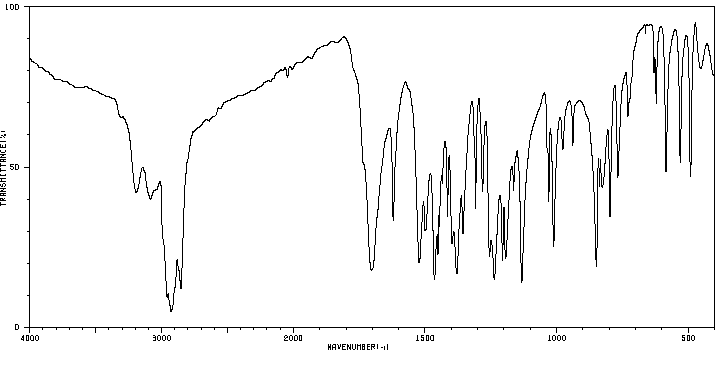6,7-dimethoxy-3,4-dihydroquinolin-2(1H)-one | 91133-47-0
中文名称
——
中文别名
——
英文名称
6,7-dimethoxy-3,4-dihydroquinolin-2(1H)-one
英文别名
6,7-dimethoxy-3,4-dihydro-1H-quinolin-2-one
CAS
91133-47-0
化学式
C11H13NO3
mdl
MFCD19370330
分子量
207.229
InChiKey
VYWZXGKPKYGBHI-UHFFFAOYSA-N
BEILSTEIN
——
EINECS
——
-
物化性质
-
计算性质
-
ADMET
-
安全信息
-
SDS
-
制备方法与用途
-
上下游信息
-
文献信息
-
表征谱图
-
同类化合物
-
相关功能分类
-
相关结构分类
计算性质
-
辛醇/水分配系数(LogP):1
-
重原子数:15
-
可旋转键数:2
-
环数:2.0
-
sp3杂化的碳原子比例:0.36
-
拓扑面积:47.6
-
氢给体数:1
-
氢受体数:3
上下游信息
-
上游原料
中文名称 英文名称 CAS号 化学式 分子量 —— 3-(2-Nitro-4.5-dimethoxy-phenyl)-propionsaeure 21164-75-0 C11H13NO6 255.227 -
下游产品
中文名称 英文名称 CAS号 化学式 分子量 1,2,3,4-四氢-6,7-二甲氧基喹啉 1,2,3,4-tetrahydro-6,7-dimethoxyquinoline 99986-04-6 C11H15NO2 193.246 1,2,3,4-四氢-6,7-二甲氧基-1-甲基喹啉 1,2,3,4-tetrahydro-6,7-dimethoxy-1-methylquinoline 100370-16-9 C12H17NO2 207.272 —— 5-bromo-N-(4-(6,7-dimethoxy-3,4-dihydroquinolin-1(2H)-yl)butyl)-2,3-dimethoxybenzamide 1285548-96-0 C24H31BrN2O5 507.425
反应信息
-
作为反应物:描述:6,7-dimethoxy-3,4-dihydroquinolin-2(1H)-one 在 1,4-二氧六环 、 lithium aluminium tetrahydride 、 乙醚 、 水 、 potassium carbonate 作用下, 生成 1,2,3,4-四氢-6,7-二甲氧基-1-甲基喹啉参考文献:名称:Iwao; Tomino, Yakugaku Zasshi/Journal of the Pharmaceutical Society of Japan, 1956, vol. 76, p. 814,816摘要:DOI:
-
作为产物:描述:3,4-二甲氧基苯丙酸 在 8-羟基喹啉 、 氟硼酸钠 、 carbonyl(pentamethylcyclopentadienyl)cobalt diiodide 、 N,N'-羰基二咪唑 、 silver carbonate 作用下, 以 四氢呋喃 、 二氯甲烷 为溶剂, 反应 4.0h, 生成 6,7-dimethoxy-3,4-dihydroquinolin-2(1H)-one参考文献:名称:钴(III)催化的C(sp2)-H酰胺化反应在室温下苯并内酰胺的合成摘要:苯并融合的内酰胺,尤其是吲哚-2-酮和二氢喹啉-2-酮是在草和天然产品中流行的结构动机。在本文中,我们开发了室温并且通过钴(III)催化的C(sp 2)-H酰胺化反应稳定合成苯并融合的内酰胺。在该协议中,由Cp * Co(CO)I 2和配体原位形成Cp * Co(III)(配体)催化剂可简化钴配合物的合成工作。简单且易于合成的1,4,2-二恶唑5-1在室温下进行分子内CH酰胺化反应,并以高达86%的收率提供了多种功能化的苯并融合内酰胺。还证明了反应的可扩展性。DOI:10.1002/adsc.202001254
文献信息
-
[EN] IMIDAZOLE COMPOUNDS AS MODULATORS OF FSHR AND USES THEREOF<br/>[FR] COMPOSÉS IMIDAZOLE SERVANT DE MODULATEURS DES RÉCEPTEURS DE LA FSHR ET LEURS UTILISATIONS申请人:MERCK PATENT GMBH公开号:WO2014209978A1公开(公告)日:2014-12-31The present invention relates to imidazole compounds, and pharmaceutically acceptable compositions thereof, useful as positive allosteric modulators of follicle stimulating hormone receptor (FSHR).本发明涉及咪唑化合物,以及由此产生的药物可接受的组合物,可用作促卵泡激素受体(FSHR)的正变构调节剂。
-
Synthesis of Lactams via Ir-Catalyzed C–H Amidation Involving Ir-Nitrene Intermediates作者:Jitian Liu、Wenjing Ye、Shuojin Wang、Junrong Zheng、Weiping Tang、Xiaoxun LiDOI:10.1021/acs.joc.0c00157日期:2020.3.20We have developed a divergent strategy for the synthesis of five- and six-membered lactams via either an amidation of sp3 C-H bonds or electrophilic substitution of arenes via Ir-nitrene intermediates. With the employment of a readily available iridium catalyst in dichloromethane or hexafluoro-2-propanol, a wide range of lactams were synthesized in good to excellent yields with high selectivity.
-
Synthesis of Indolones and Quinolones by Reductive Cyclisation of <i>o</i>-nitroaryl Acids using Zinc Dust and Ammonium Formate作者:Bhima Reddy Dinesh、A. Ramesha Baba、K. Udaya Sankar、D. Channe GowdaDOI:10.3184/030823408x320647日期:2008.5A novel protocol for the synthesis of indolone and quinolone derivatives from o-nitroaryl acids was developed using Zn and HCO2NH4 under supercritical fluid carbon dioxide (scCO2) medium. The process involves the reduction of the nitro group to an amino group followed by in situ cyclisation.
-
Visible‐Light Induced C(sp <sup>2</sup> )−H Amidation with an Aryl–Alkyl σ‐Bond Relocation via Redox‐Neutral Radical–Polar Crossover作者:Hyeyun Keum、Hoimin Jung、Jiwoo Jeong、Dongwook Kim、Sukbok ChangDOI:10.1002/anie.202108775日期:2021.11.22Herein, a photocatalyzed, intramolecular C(sp2)−H amidation of N-benzoyloxyamides has been developed to afford δ-benzolactams with an aryl-alkyl σ-bond relocation. Upon the formation of amidyl radical via reductive N−O bond cleavage, selective radical ipso-addition followed by a redox-neutral radical–polar crossover was suggested to be responsible for the preferential C−C bond migration.在此,已开发出N-苯甲酰氧基酰胺的光催化分子内 C(sp 2 )-H 酰胺化,以提供具有芳基-烷基σ -键重定位的δ -苯内酰胺。一旦经由还原N-O键断裂形成酰胺基的基团,选择性自由基本位-addition接着是氧化还原中性基极交叉建议负责优先C-C键的迁移。
-
Ruthenium-Catalyzed Intramolecular Arene C(sp<sup>2</sup>)–H Amidation for Synthesis of 3,4-Dihydroquinolin-2(1<i>H</i>)-ones作者:Wenlong Sun、Cho-Hon Ling、Chi-Ming Au、Wing-Yiu YuDOI:10.1021/acs.orglett.1c00781日期:2021.5.72-dioxazol-5-ones to form dihydroquinoline-2-ones in excellent yields with excellent regioselectivity via a formal intramolecular arene C(sp2)–H amidation. The reactions of the 2- and 4-substituted aryl dioxazolones proceeds initially through spirolactamization via electrophilic amidation at the arene site, which is para or ortho to the substituent. A Hammett correlation study showed that the spirolactamization
表征谱图
-
氢谱1HNMR
-
质谱MS
-
碳谱13CNMR
-
红外IR
-
拉曼Raman
-
峰位数据
-
峰位匹配
-
表征信息
同类化合物
(S)-4-(叔丁基)-2-(喹啉-2-基)-4,5-二氢噁唑
(SP-4-1)-二氯双(喹啉)-钯
(E)-2-氰基-3-[5-(2,5-二氯苯基)呋喃-2-基]-N-喹啉-8-基丙-2-烯酰胺
(8α,9S)-(+)-9-氨基-七氢呋喃-6''-醇,值90%
(6,7-二甲氧基-4-(3,4,5-三甲氧基苯基)喹啉)
(1-羟基-5-硝基-8-氧代-8,8-dihydroquinolinium)
黄尿酸 8-甲基醚
麻保沙星EP杂质D
麻保沙星EP杂质B
麻保沙星EP杂质A
麦角腈甲磺酸盐
麦角腈
麦角灵
麦皮星酮
麦特氧特
高铁试剂
高氯酸3-苯基[1,3]噻唑并[3,2-f]5-氮杂菲-4-正离子
马波沙星EP杂质F
马波沙星
马来酸茚达特罗杂质
马来酸茚达特罗
马来酸维吖啶
马来酸来那替尼
马来酸四甲基铵
香草木宁碱
颜料红R-122
颜料红210
颜料红
顺式-苯并(f)喹啉-7,8-二醇-9,10-环氧化物
顺式-(alphaR)-N-(4-氯苯基)-4-(6-氟-4-喹啉基)-alpha-甲基环己烷乙酰胺
非那沙星
非那沙星
青花椒碱
青色素863
雷西莫特
隐花青
阿莫地喹-d10
阿莫地喹
阿莫吡喹N-氧化物
阿美帕利
阿米诺喹
阿立哌唑溴代杂质
阿立哌唑杂质B
阿立哌唑杂质38
阿立哌唑杂质1750
阿立哌唑杂质13
阿立哌唑杂质
阿立哌唑杂质
阿尔马尔
阿加曲班杂质43







